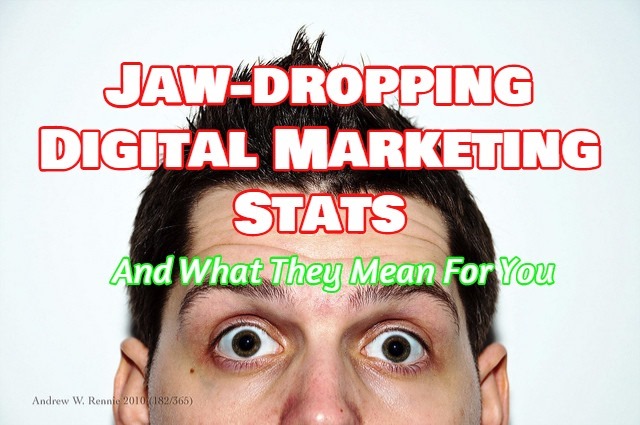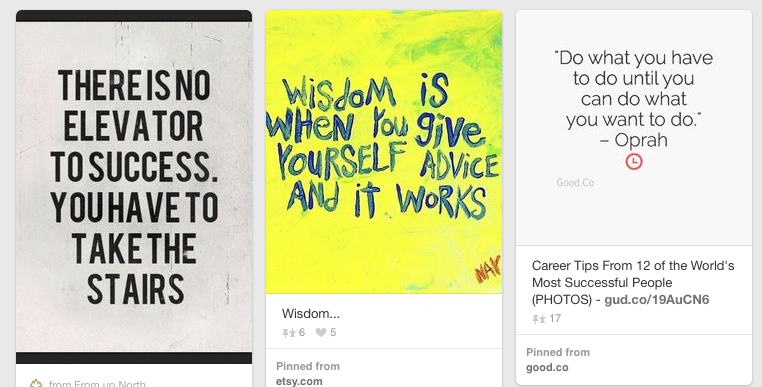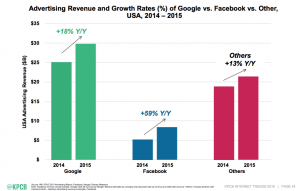
As a marketing professional who believes in the power of big data, I see statistics all of the time. But every once in a while I read something that just makes me stop and go, “…Really??“
So recently I set out to document all of those “really??” moments by collecting compelling, action-able, and downright jaw-dropping stats about digital marketing. But instead of just dumping them all onto the screen and letting you sort through them like some disorganized yard sale, I tried to corral these facts.
I connected them to big-picture takeaways that will hopefully reassure your digital marketing strategy, or provide a persuasive argument for changing course to achieve better results.
I’ve broken these statistics down into 4 specific areas.
1. Social Media Directly Affects Sales
52% of online adults use multiple social media sites [1]
While marketers are always trying to track the effectiveness of brand awareness on social media, having a presence there clearly works. Whether people see your sponsored post or, more importantly, observe a post by a friend who references your product or service, the message gets through.
Of course, one of the advantages of marketing through social media is the ability to track behavior. Even if you can’t measure the power of an impression, you can analyze post engagement, and follow the path of a user after she clicked on your social media post.
54% of social salespeople have tracked their social selling back to at least 1 closed deal [2]
Marketers who spent on social channels registered a nearly 25% lift in conversions compared with purely organic social efforts (2.82% average conversion rate vs. 2.26%). (Source)
Your customers are using social media; why wouldn’t you try to engage them? Whether your company is using its channels to establish a brand voice and promote deals, or you personally wield a social account to connect with leads and retain customers, the social universe is ripe with sales potential.
2. Email Continues To Be Popular And Effective
People who buy products marketed through email spend 138% more than those who don’t get email offers [3]
Email is blowing up. Yes, you read that correctly; this is not 2003. It seems that more than ever, email is dominating many brands’ digital marketing initiatives. This is due in part to the growing adoption of mobile devices into our lives. For context, think about your own smartphone or tablet behavior. Many of us check our email compulsively while on the go, even if we’re not expecting an important message.

Brands are clearly embracing email
44% of email recipients made at least one purchase last year based on a promotional email [4]
A common critique of content marketing is that ROI is either difficult to track or generally dubious. However, as this figure shows, email is an affordable way to generate sales. It is to this extent said that if marketers optimized their emails for image blocking, return on investment (ROI) would increase by more than 9%. While some people are more comfortable with other forms of messaging such as chat or social media exchanges, email still leads the charge of cost-effective marketing through messaging. And with the advancement of automation software, producing and tracking “old school” digital messages is easier than ever.
3. Blogs Have A Huge Impact On SEO
Blogs that post daily get 5 times more traffic than those that post weekly or less [5]
This stat applies to most blogging sites irrespective of the industry they belong to. Blogs present an opportunity to add unique content to your website on a regular basis. While Twitter, Tumblr, and other websites are shrinking the length of blogs, clearly search engines still favor in-depth, long form content.
The idea is that longer posts provide more information, and are therefore more valuable to users. The takeaway here? Flesh out your blog topics. Spend a little extra time and dig deeper (of course, don’t sacrifice quality for quantity). [6]
- traffic increases by 53% at 51 blog posts
- Blog traffic goes up by 3 times after 100 posts
- Blog traffic increases 4.5 times after 200 posts
Adding a blog to your website just isn’t enough. In order to draw a meaningful amount of traffic, you have to provide value to users on an ongoing basis. This means writing regular posts, which can be challenging. At the risk of stating the obvious, writing is hard and time-consuming, especially if you’re going the extra mile to offer special content. However, the payoff to regular posts is well worth it.
The solution? Create an editorial calendar. Plan your topics ahead of time. This way, when you’re facing a time crunch, you can check your calendar and get a jumpstart on the writing process, rather than starting from scratch every time. Another option is to hire a writer or marketing agency to create posts for you. Either way, as statistics show, maintaining a blog that includes keywords and necessary metadata is key to boosting organic search traffic.
Articles that are at least 1500 words long attract more backlinks [7]
In addition to currying favor with search engines, longer posts play another important role in SEO: backlinking. Again, this touches on the assumption that longer posts are probably more in-depth and relevant to your audience.
When people read a blog post with a compelling point of view or interesting data, they want to share it. Shares not only stroke your ego on a job well done, but they signal to Google, Yahoo and Bing that your content is important enough to be passed around the internet (of course, it helps if the sites that reference your content use DoFollow links. In turn, search engines will improve the rank of your awesome, long blog post when someone enters a relevant query.
3. Video Helps Your Sales Funnel
A study showed that those using video on product pages saw a 134% boost in conversions [8]
Landing pages are an important part of the sales funnel, customer journey, or whatever terms you use to describe the purchase process. They can be used to provide content, such as a free download, in exchange for a user’s email address. This transaction is an example of a conversion. Tech company, Panorama9 created an entertaining explainer video for its landing page
It’s kind of a no-brainer then that video works well with a landing page. Video is insanely popular, and can be useful in providing product information to users, showing a quick, emotional narrative about the brand, and more. Once people demonstrate interest in your product or service by clicking the link, they’re more likely to be swayed by a video.
Web users viewing video stay two minutes longer and are 64% more likely to buy something [9]
It’s important to create marketing materials for every stage of the sales funnel. It’s also important to note that not every type of video may be as effective at every stage. For example, a video that introduces a brand might not sway someone who’s deciding whether or not to click “purchase”. On the other hand, if a customer has added an item to her shopping cart, watching a persuasive and informative product video catering to her specific questions can re-assure a decision to buy.
4. Content Marketing Is Used By A Variety Of Industries
60% of the most effective B2C marketers have a documented content strategy [10]
Hopefully by now we can dispel the myth that B2Bs can’t succeed with content marketing. While some services may not be as exciting as, say, a fun ecommerce company, every potential customer can benefit from a brand’s valuable content. Whether it’s an insightful industry blog, social media campaign designed to create a compelling brand voice, or helpful white-paper series, B2Bs can and do benefit from distributing great content.

Email automation brand, Constant Contact has 119 popular Pinterest boards, including a board on inspiring quotes
56% of marketers are leveraging software to “manage their content workflow and distribution [11]
If you don’t already have a content marketing strategy in place for your B2C brand, what are you waiting for? Social media is the perfect venue for sharing images and videos of your products. Allow customers to feel empowered with the ability to leave comments and Tweet at you. Create an email newsletter to stay connected with leads and customers.
While this statistic doesn’t specify the amount of success these companies have with content marketing, the shockingly high number indicates that it’s working.
Stephen Moyers is a Writer, Web Designer, Blogger, Technology lover. He is currently associated with SPINX Digital – a Digital Marketing Agency based in LA, California.You can follow Stephen on Twitter and Google+.
Jaw-dropping Digital Marketing Stats And What They Mean For You
The post Jaw-dropping Digital Marketing Stats And What They Mean For You appeared first on Search Engine People Blog.
(250)






